10 Best Native Plants for Southeast Virginia
BY JEFFERY KEUSSEYAN | MAY 1ST, 2023 | LANDSCAPING, SOUTHEAST VIRGINIA, VIRGINIASoutheast Virginia is blessed with a temperate climate where you can enjoy the outdoors all year round. From snapping pictures of seals in Blakeney Point to taking long walks in Buckroe Beach and Park, there are plenty of activities for nature lovers to enjoy. Wondering how you can give back to the local ecosystem? With 10 of the best native plants for Southeast Virginia, you get to spruce up your backyard and support the local wildlife habitat.
Native plant gardens are generally low-maintenance, water-efficient, and essential to the survival of butterflies and pollinators. However, it is important to note that not all Virginia-native plants thrive in this part of the state. The following section will list some of the best plants for your native Southeast landscape, along with their characteristics.
- Red Chokeberry
- Common Buttonbush
- American Beautyberry
- American Witch Hazel
- Common Winterberry
- Eastern Redbud
- Flowering Dogwood
- Black Huckleberry
- Butterfly Milkweed
- Beebalm
- How to Choose Native Plants for Your Southeast Landscape
- FAQ About Native Southeast Plants
- Where to Find Native Plants in Southeast Virginia
10 Best Native Plants for Southeast Virginia
This part of Virginia, east of Piedmont, lies in USDA Hardiness zones 7b and 8a. The temperature typically varies from 32 to 87 degrees Fahrenheit, with muggy summers and cold, windy winters. Hampton Roads and Chesapeake Bay are not prone to prolonged periods of extreme weather, allowing a variety of plant species to thrive.
1. Red Chokeberry (Aronia arbutifolia)
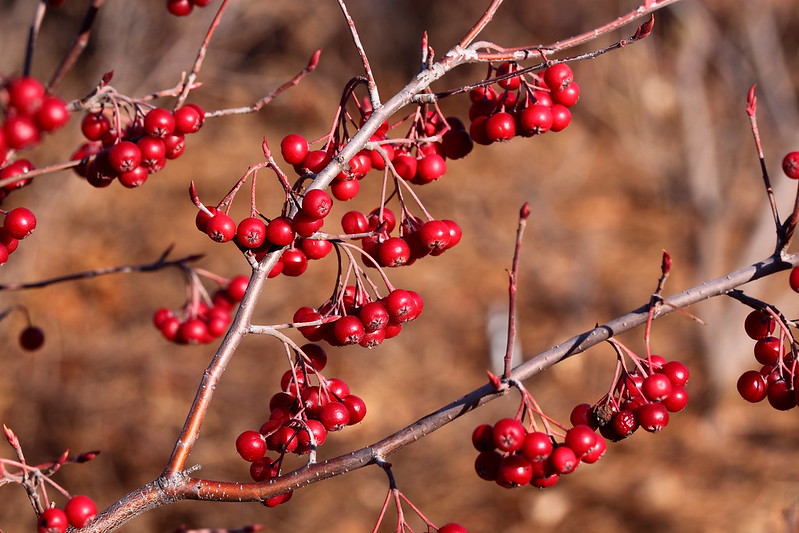
Photo Credit: Mr.TinMD / Flickr / CC BY-ND 2.0
Red chokeberry is a multi-stemmed deciduous shrub with green leaves that turn orangish-red in the fall. During this period, pear-shaped berries appear and may persist through winter. These fruits can be used in making jams, but can also be eaten raw!
Red chokeberry is an excellent addition to your native landscape with high wildlife value. It is a source of nectar to bees and butterflies. Additionally, this plant’s fruits are an excellent food source for a variety of birds.
Plant type: Shrub
USDA Hardiness Zone: 4 to 9
Sun: Full sun, partial sun
Soil: Clay, loam
Duration: Perennial
Fragrance: Sweet-scented
Bloom time: February – May
Water needs: Average
Mature height: 5 to 10 feet
Potential hazards: Leaves, bark, stem, and stones (seed pit) are all toxic. Chewing on the stems and leaves could be fatal.
Maintenance: Low
2. Common Buttonbush (Cephalanthus occidentalis)
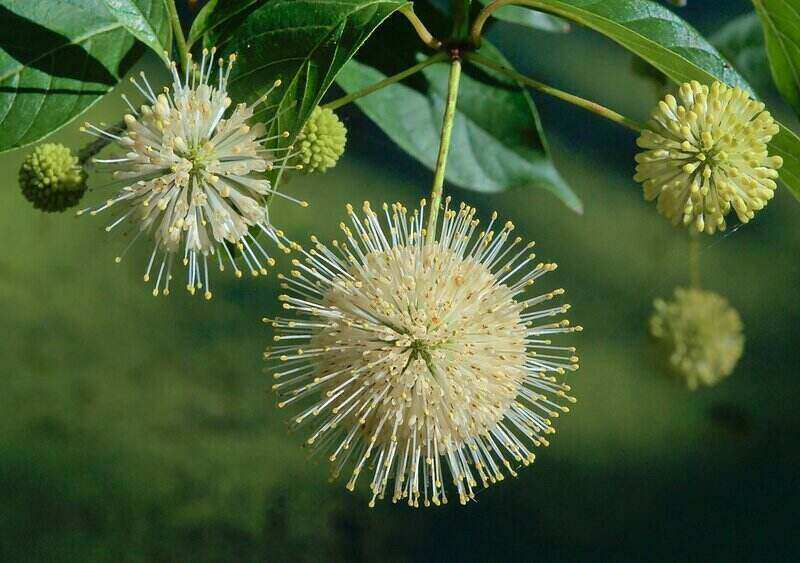
Photo Credit: The Cosmonaut / Wikimedia Commons / CC BY-SA 4.0
Common buttonbush is a hardy shrub with green leaves and round flower clusters. They tend to bloom during midsummer. This native plant species is a fast grower, making it useful to prevent erosion in wetlands or near rivers. Common buttonbush attracts more than 24 species of birds, as well as butterflies and pollinators. It is perfect for rain and cottage gardens.
Plant type: Shrub
USDA Hardiness Zone: 5 to 11
Sun: Full sun, partial shade
Soil: Loam, sand
Duration: Perennial
Fragrance: Dried flowers and leaves smell like freshly-mown grass
Bloom time: June – September
Water needs: Average, high
Mature height: 5 to 12 feet
Potential hazards: Leaves are toxic to domesticated animals.
Maintenance: Low
3. American Beautyberry (Callicarpa americana)
American beautyberry is a bushy, deciduous shrub that is easy to grow. In early summer, it bears clusters of small flowers that can be pink or white in color. These flowers are followed by bright violet fruits which encircle the plant’s woody stems. The best fruit production occurs when the shrubs are planted in groups. Unfortunately, American beautyberries may die back to the ground in areas with harsh winters.
Plant type: Shrub
USDA Hardiness Zone: 7 to 11
Sun: Full sun to partial shade
Soil: Loam, Sand
Duration: Deciduous perennial
Fragrance: Citrus
Bloom time: Summer
Water needs: Low (one inch per week)
Mature height: 4 to 8 feet
Maintenance: Low
4. American Witch Hazel (Hamamelis virginiana)
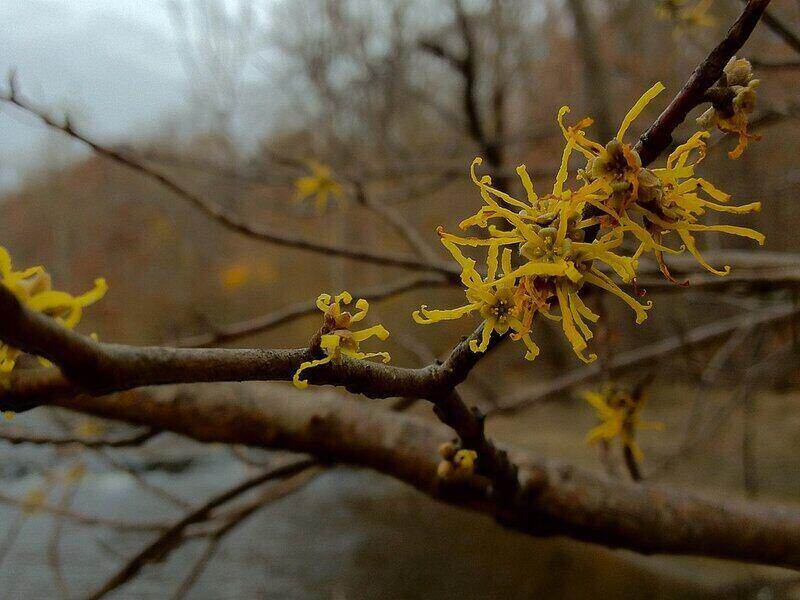
Photo Credit: Fritzflohrreynolds / Wikimedia Commons / CC BY-SA 3.0
Planted as a shrub or small tree, the American witch hazel boasts sweetly-scented flowers in fall and early spring. Each flower consists of 4 golden yellow petals. This native plant sports smooth oval leaves that turn golden yellow in the fall. No regular pruning is required for this plant, but you can always remove any damaged, dead, or weak shoots.
The American witch hazel is the species from which medicinal witch-hazel extract is made. Overall, its smooth gray bark and colorful fall foliage make it a great addition to your native garden.
Plant type: Shrub, tree
USDA Hardiness Zone: 3 to 8
Sun: Full sun, partial shade, shade
Soil: Clay, loam, sand
Duration: Perennial
Fragrance: Sweetly scented
Bloom time: September to December
Water needs: Average
Mature height: 15 to 20 feet
Maintenance: Prune in spring to control its shape and size.
5. Common Winterberry (Ilex verticillata)
Common winterberry is a stunningly beautiful shrub that is native to the eastern United States. It is classified as dioecious, so the male variety planted close to the female plant will lead to the production of bright red berries. Unlike the classic Christmas holly, this species loses its leaves every autumn. However, you may still use the red-fruited branches to make lovely home decorations. Common winterberry is great as a specimen plant or in mixed shrub borders.
Plant type: Shrub
USDA Hardiness Zone: 3 to 9
Sun: Full sun to partial shade
Soil: Clay, loam, sand, moist, acidic
Duration: Perennial
Bloom time: April – July
Water needs: Medium to high
Mature height: 3 to 15 feet
Potential hazard: Fruit can be poisonous to pets and people
Maintenance: Low
6. Eastern Redbud (Cercis canadensis)
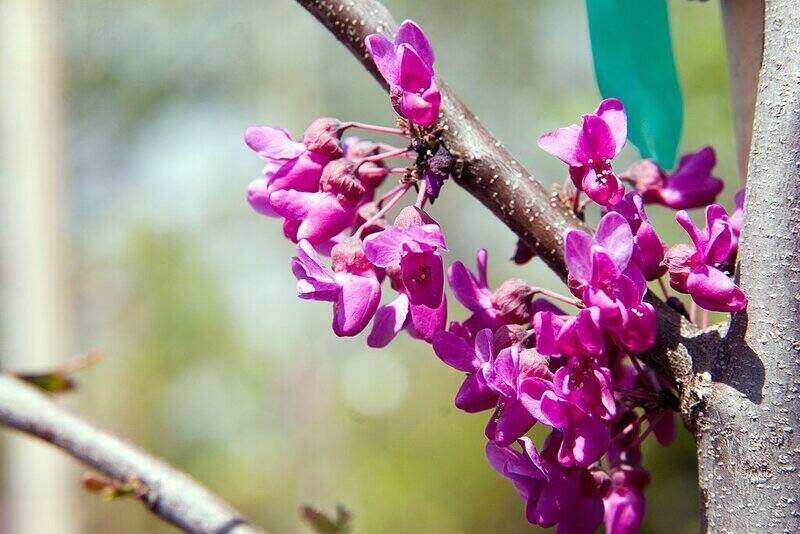
Photo Credit: David J. Stang / Wikimedia Commons / CC BY-SA 4.0
Eastern Redbud, also known as ‘Ace of Hearts’, is a deciduous tree with unique branching patterns. It does not tolerate root disturbance, so be sure to pick a proper permanent spot for this plant in your garden. The rose pink to light purple flowers mature in early spring, and attract scores of bees and butterflies.
It is important to note that this native plant is very sensitive to herbicides and other chemicals sprayed on lawns. Used for shrub borders or as a specimen plant, eastern redbud can provide your native garden with an elegant touch.
Plant type: Tree
USDA Hardiness Zone: 4 to 9
Sun: Full sun or partial shade.
Soil: Any moist, well-draining, nutrient-rich soil
Duration: Perennial
Bloom time: Spring
Water needs: Keep the soil moist to a depth of 2 to 3 inches; watering schedule depends on your soil type, but you should water about once per week
Mature height: 20 to 30 feet tall with a 25 to 35 foot spread
Maintenance: Requires little pruning
7. Flowering Dogwood (Cornus florida)
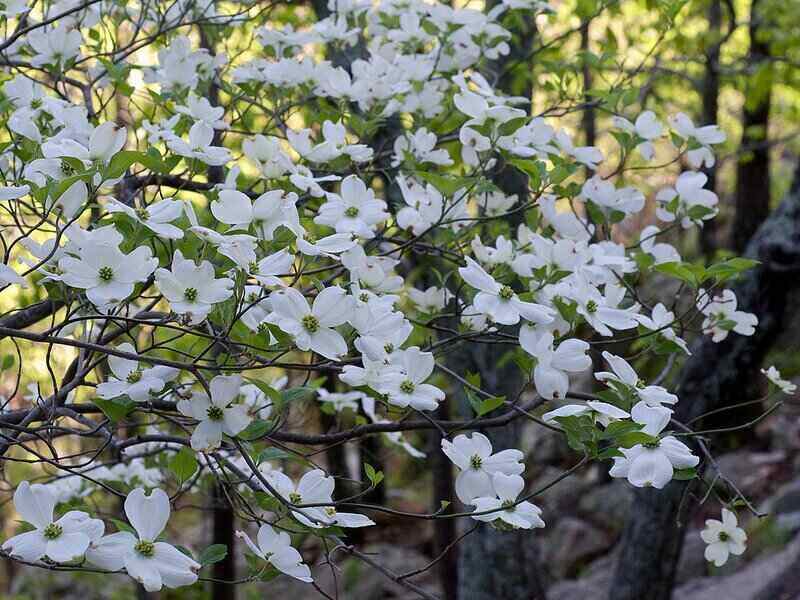
Photo Credit: Eric Hunt / Wikimedia Commons / CC BY-SA 4.0
Flowering dogwood is another species that can be used as a shrub or ornamental tree. This native plant produces showy, long-lasting fruits that are a valuable source of food for songbirds and small mammals. In hot and moist summers, you can add a layer of mulch to keep the roots cool.
Flowering dogwood is a perfect fit for shrub borders, woodland gardens, or naturalized gardens. Many landscapers and gardeners regard this plant as one of the best flowering trees native to the area.
Plant type: Tree
USDA Hardiness Zone: 5 to 9
Sun: Grows best in part shade but can tolerate full sun
Soil: organically rich, moist, acidic soil
Duration: Perennial
Fragrance: Slightly fragrant
Bloom time: March – June
Water needs: Medium
Mature height: 15 to 30 feet, sometimes reaching up to 40 feet
Potential hazards: The fruit is poisonous to humans
Maintenance: Low
8. Black Huckleberry (Gaylussacia baccata)
Black Huckleberry is a low-growing deciduous shrub, with a foliage that turns orange and crimson in the fall. Urn-shaped red to pink flowers appear in late spring to mid summer. These flowers are followed by edible purplish-black berries that humans, birds, and other wildlife can enjoy.
Black huckleberry has a shallow-spreading root system that helps prevent erosion on rocky hillsides. This native plant is perfect for wildlife gardens, shrub borders, and foundation plantings.
Plant type: Shrub
USDA Hardiness Zone: 4 to 7
Sun: Full sun, partial shade
Soil: Loam, sand
Duration: Perennial
Fragrance: Sweet berry smell
Bloom time: May – July
Water needs: Low
Mature height: 1 to 3 feet
Maintenance: Low
9. Butterfly Milkweed (Asclepias tuberosa)
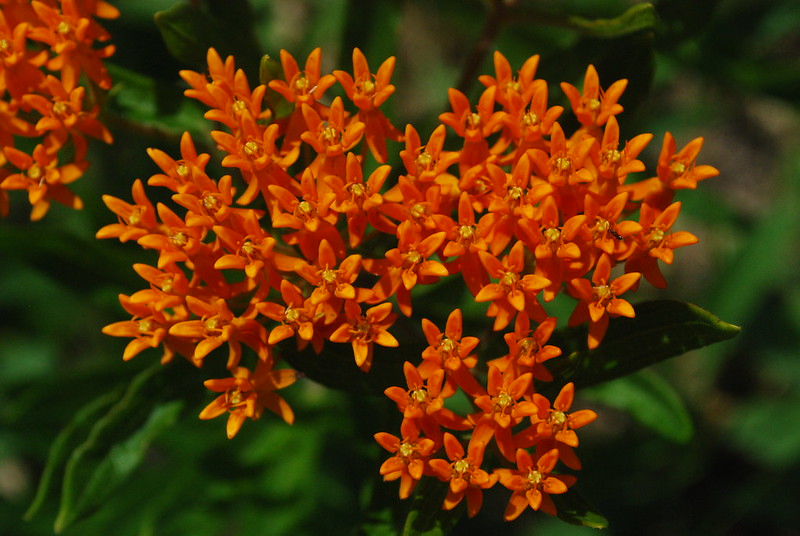
Photo Credit: Joshua Mayer / Flickr / CC BY-SA 2.0
Butterfly milkweed is a bushy perennial that is native to most of the United States. It boasts clusters of yellow-orange flowers which bloom continuously throughout summer. These flowers are followed by seed pods in the fall. This native perennial performs quite well in poor, dry soils. More importantly, milkweed doesn’t handle transplanting very well and should be left undisturbed once established.
A great nectar source for birds and insects, butterfly milkweed is critical to the survival of monarch butterflies. Consider adding this plant to your native landscape and help reverse their fortune.
Plant type: Perennial herb
USDA Hardiness Zone: 3 to 9
Sun: Full sun
Soil: Clay, loam, sand
Duration: Perennial
Fragrance: Vanilla
Bloom time: May – September
Water needs: Low
Mature height: 1 to 2 feet
Potential hazards: Can be lethal to horses, cats, and dogs
Maintenance: Low
10. Beebalm (Monarda)
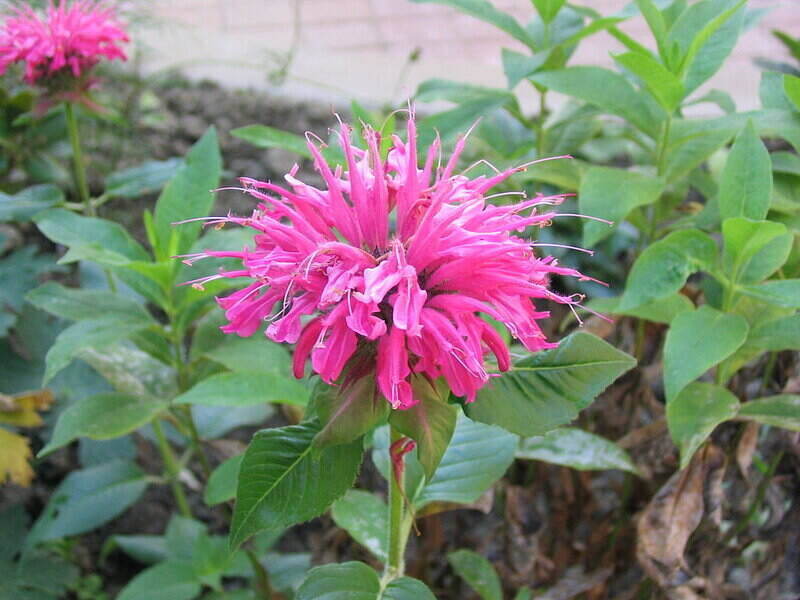
Photo Credit: Alan Silvester / Wikimedia Commons / CC BY-SA 2.0
Bee balm is a clump-forming perennial that is a magnet for butterflies, hummingbirds, and beneficial pollinators. It is one of the showiest summer-blooming perennials you can get for your native garden. Bee balms have very distinctive tubular flowers that help you create visually stunning border displays. These Monarda species combine well with other summer perennials, such as phlox, and make excellent cut flowers.
Plant type: Perennial plant
USDA Hardiness Zone: 3 to 9
Sun: Full sun, partial shade
Soil: Chalk, clay, loam, sand
Duration: Perennial
Fragrance: Minty aroma when leaves are crushed
Bloom time: July – August
Water needs: Average
Mature height: 1 to 4 feet
Maintenance: Average
How to Choose Native Plants for Your Southeast Landscape
All of the plants mentioned above are native to Southeast Virginia, and should grow properly under normal circumstances. However, there is another decisive factor that cannot be overlooked: your landscape.
Before purchasing any of these native plants, you should double-check on your property’s soil type, exposure levels, and water availability as a starting point. Each of these factors can affect the plant’s growing ability in your backyard.
FAQ About Native Southeast Plants
Several of the plants listed in this article are native to Virginia Beach. Virginia Beach Native Plants include:
• Butterfly Milkweed
• Cardinal Flower
• Inkberry Holly
• Fall Phlox
• Eastern Redbud
• Sweetbay Magnolia
• Trumpet Honeysuckle
• Smooth Alder
• Virginian Witch Hazel
• American Beautyberry
The purple fringeless orchid is one of the rarest orchid species in the state. It is a short plant with a cluster of pinkish-purple flowers, with a maximum height of 3 feet. The Department of Conservation and Recreation ranks it as ‘critically imperiled’, with estimates that less than 1,000 of these plants remain in Virginia.
Invasive plant species are unwanted for a reason. They harm native plants and basically threaten the entire state’s forests and landscapes. Invasive plants can include grasses, trees, shrubs, and wildflowers.
Below are some of the non-native and invasive plant species in Virginia:
• Alligator weed
• Japanese sand sedge
• Chinese privet
• Marsh Dewflower
For more information on invasive plants, you can visit the Virginia Department of Forestry website.
The tree-of-heaven (Ailanthus altissima) is a deciduous tree that was introduced as an ornamental species. It has leaves that resemble native sumac and walnut species. Tree-of-heaven is originally from China and classified as invasive in the state of Virginia. Concerning the southeastern cities, it can be found in Virginia Beach, Chesapeake, and Hampton.
Northern Virginia’s native plants include:
• Red columbine
• Common yarrow
• Yellow wild indigo
• White turtlehead
• Maryland golden-aster
• Spring beauty
• Eastern rose-mallow
• Turk’s-cap lily
Plants native to Virginia’s Capital Region include:
• Black oak
• Willow oak
• Sassafras
• Common partridge-pea
• Smooth oxeye
• Arrow arum
• Wild pink
• Red chokeberry
Where to Find Native Plants in Southeast Virginia
Plant species native to Southeast Virginia will grow naturally in forests, national parks, wetlands, and even near your own property.
Fortunately, there are several nurseries and garden centers that sell native plants to help with your backyard transformation. Not only do they sell them, but they can provide answers to any of your questions regarding native species and how to grow them properly.
For information on wildflowers, wildlife service, and native plant sales throughout the state of Virginia, visit the official webpage of the Virginia Native Plant Society.
But why stop at native plants? With several low-maintenance landscaping ideas that include hardscaping features and Virginia grass types, you can design a unique and visually appealing outdoor space with minimal backyard chores.
Your lawn will still require the occasional upkeep. Whether you live in Virginia Beach, Newport News, or Suffolk, we can help you hire a local lawn care professional to handle the yard’s mowing, trimming, or edging.
Main Photo by: Eric Hunt / Wikimedia Commons / CC BY-SA 4.0